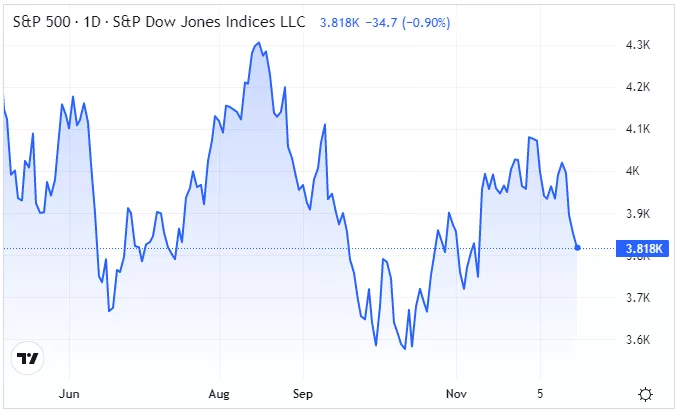Wall Street Slides Again On Recession Fears

On Monday, for the fourth consecutive session, Wall Street closed lower as investors shunned riskier assets amidst fears of a recession. The Dow Jones, S&P 500, and Nasdaq all fell by 0.49%, 0.90%, and 1.49% respectively.
The four-day decline was sparked on Wednesday after Fed Chair Jerome Powell poured cold water on hopes of a more restrained approach to monetary policy going forward.
In his speech, which followed the Federal Reserve’s decision to raise rates by 0.5%, Powell said more rate increases were on the way, generating fear amongst investors that this ongoing aggressiveness would push the US into recession.
Year to date, the Dow, S&P 500, and Nasdaq have slid by 9.85%, 19.90%, and 32.59% respectively, setting all three up for their worst year since the Great Recession in 2008.
Meanwhile, yesterday, US Treasury yields moved in the opposite direction. A rising yield signals decreasing demand for US Treasury bonds which, in the current climate, suggests investors are being influenced by the prospect of how higher rates will go in the coming months.
Why bother buying government bonds if you might be able to earn a comparable rate of interest by just leaving money in the bank?

Source: TradingView - Past performance is not a reliable indicator of future results
Whilst rising interest rates are wreaking havoc in the stock markets, some stocks stand to potentially benefit from higher rates, in particular, banks.
Year to date, the Bank of America share price has fallen 30%, greatly underperforming the wider S&P 500, of which it is a constituent. The logic for the poor performance is not hard to untangle.
A gloomy economic outlook is a bad news for banks. Economic downturns tend to cause an increase in loan defaults and can also cause demand for new loans to plummet, both of which hit earnings. However, as many stocks sank during yesterday’s session, the Bank of America share price crept up 1.14%.
This is possibly due to investors weighing the impact of further rate increases on Bank of America’s prospects for 2023.
After years of operating on record low-interest rates, banks are now able to generate more income from interest payments. But higher interest rates work both ways. As well as charging more interest, banks also have to pay a higher rate of interest on customers’ deposits, which can eat into profit margins.
Bank of America has a fairly high proportion – 40% in 2021 – of noninterest-bearing deposits, meaning its income generated from interest stands to potentially benefit from further rate increases. Indeed, this was evident in the bank’s third-quarter results, in which it reported a net interest income of $13.8 billion, an increase of almost 20% year on year.
However, Q3 earnings also revealed a significant increase in the bank’s provision for credit losses over the previous quarter, reminding investors of the very real risks ahead for the industry.
(Click on image to enlarge)

Depicted: Admirals MetaTrader 5 – Bank of America Daily Chart. Date Range: 12 August 2021 – 19 December 2022. Date Captured: 20 December 2022. Past performance is not a reliable indicator of future results.
(Click on image to enlarge)

Depicted: Admirals MetaTrader 5 – Bank of America Weekly Chart. Date Range: 5 June 2016 – 19 December 2022. Date Captured: 20 December 2022. Past performance is not a reliable indicator of future results.
More By This Author:
EUR Supported By Subsiding US Inflation, China Data In FocusTrading Bank Of America Post Q3 Earnings
Why Do Interest Rates Affect The Stock Market?
Disclaimer: This material does not contain and should not be construed as containing investment advice, investment recommendations, an offer of or solicitation for any transactions in financial ...
more


